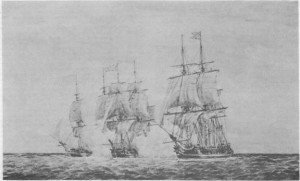George Paris Monke
Died 1828. He was the only son of a captain in the Horse Guards.
Monke joined the navy in June 1775 aboard the Worcester 64, Captain Mark Robinson, going out to Cape Finisterre and Gibraltar in the following year. In March 1777 he was accepted aboard the Fox 28, Captain Patrick Fotheringham, which frigate on 7 June was captured by two American vessels of a similar size. Monke was imprisoned on one, the Boston, which escaped a month later when the Fox was recaptured with the other American vessel by the Rainbow 44, Captain Sir George Collier. After a further imprisonment in the city of Boston, Monke was eventually exchanged, and upon rejoining the Fox he returned to England with that vessel in early 1778.

Captain Monke had only been in the navy for a matter of two years when the frigate he was serving on, the Fox, was captured by two American vessels.
Shortly afterwards Monke joined the Courageux 74, Captain Lord Mulgrave, in which he fought at the Battle of Ushant on 27 July 1778, and with which he remained until appointed acting-lieutenant of the fire-ship Harpy 18, Commanders Phillip Walsh and William Cayley in September 1780. He was officially commissioned lieutenant of the Warrior 74, Captain Sir James Wallace, on 17 November 1781, in which capacity he fought at the Battle of the Saintes on 12 April 1782. Next appointed first lieutenant of the prize ship Jason 64, Captain John Aylmer, Monke returned to England, although the Jason s departure from Jamaica was delayed and she thus avoided the fate of Rear-Admiral Thomas Graves prize convoy that was decimated by the Central Atlantic Hurricane on 16 September 1782.
In June 1783 Monke provided testimony in support of a marine lieutenant, Charles Bourne, at his trial for libel and assault upon Captain Sir James Wallace. The dispute had arisen during their time aboard the Warrior where Bourne had formed a faction with Monke against the other officers and the captain. Monke s testimony was by implication deplored by the judge, and Bourne was found guilty leading to a heavy sentence.
From the end of 1790 Monke commanded the cutter Speedwell 16 in the Channel, prior to entering Woolwich in the spring of 1791 in the event of her being required to join the Impress Service. She then served in the North Sea, capturing a similarly rated smuggling vessel, the Ostend-based Hell-Afloat 14, off Yorkshire on 31 May 1792 in which engagement several of the latter s crew were killed.
With a hot press impending at the start of the French Revolutionary War in 1793 the Speedwell was sent to bring shipwrecked sailors home from Jutland, and having embarked over one hundred men Monke s passage home was one fraught with the fear that they might overpower him in order to avoid being forced into the navy. Indeed, so traumatic was this voyage that he was obliged to resign his command through ill health in August 1793.
Monke later served aboard the Maidstone 32, Captain John Mathews, and the newly-commissioned Ville de Paris 110, Captain Walter Locke, from which ship he was promoted commander on 11 March 1797, just prior to that vessel sailing for the Mediterranean. His promotion led to a further protracted period of unemployment, during which time he produced a work entitled A Vocabulary of Sea Phrases and Terms of Art used in Seamanship and Naval Architecture , including a version in French to allow prize-masters to sail captured vessels.
In August 1808 Monke took the Centurion 50 out to Halifax as a store ship, and she remained on this station, initially as a hospital ship. He was still at Halifax in command of the sloop Driver when the frigate Statira 38 arrived from Portsmouth in November 1809, and as her captain, Charles Boys, had died at sea from the Walcheren Fever Monke assumed the command in an acting capacity. Accordingly he was posted captain on 12 January 1810, and after sailing for the Leeward Islands he was present at the capture of Guadeloupe in February before leaving her shortly afterwards.
In October 1810 he joined the Pallas 32, but having spent some time cruising off Norway his command was wrecked on returning to Leith in the Firth of Forth on 18 December. The Nymphe 36, Captain Edward Sneyd Clay was also wrecked on the same night, with both ships apparently mistaking a burning lime kiln ashore for a lighthouse.
Monke did not enjoy any further employment and he died on 14 November 1828 at Dunkirk.
